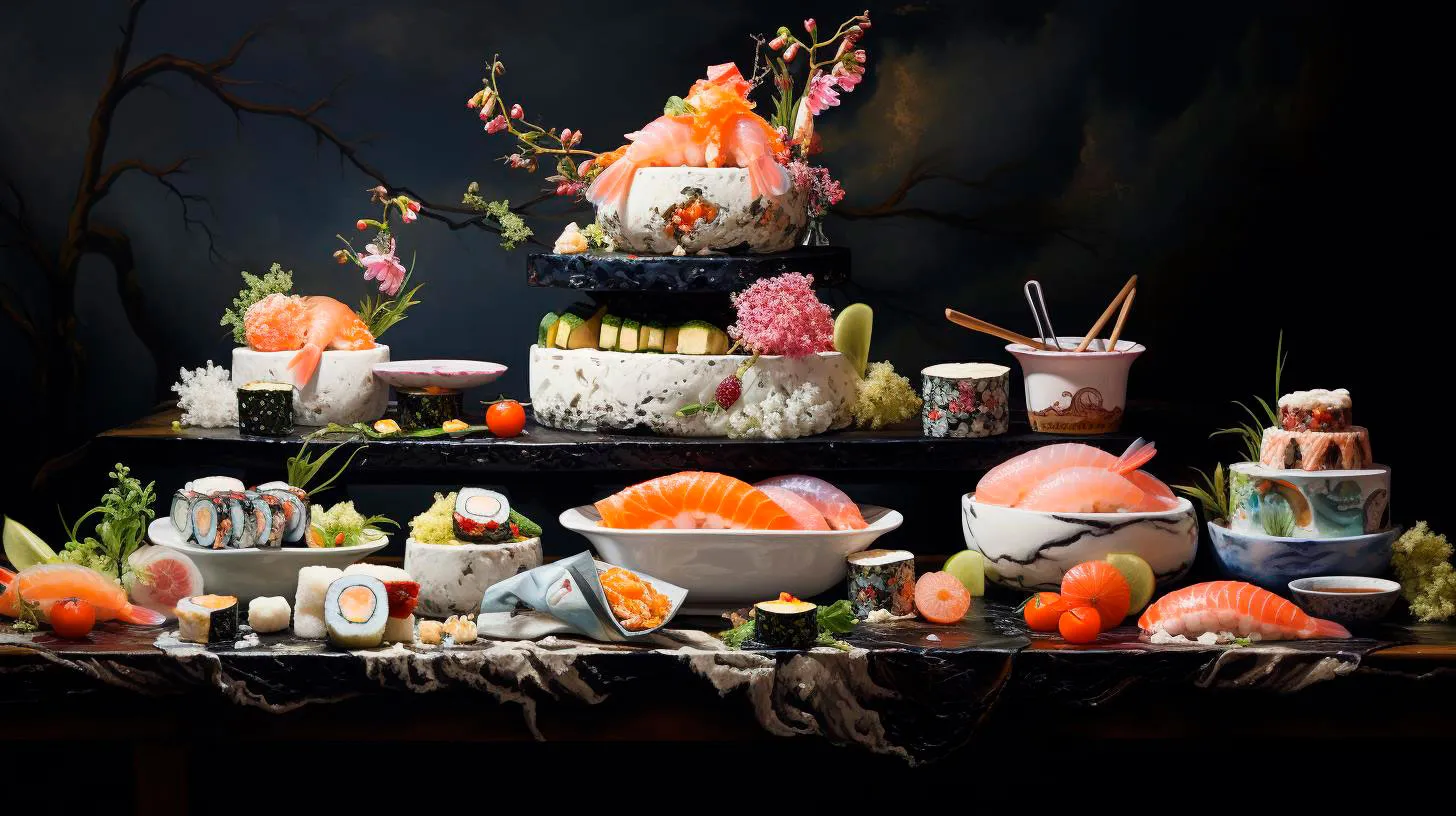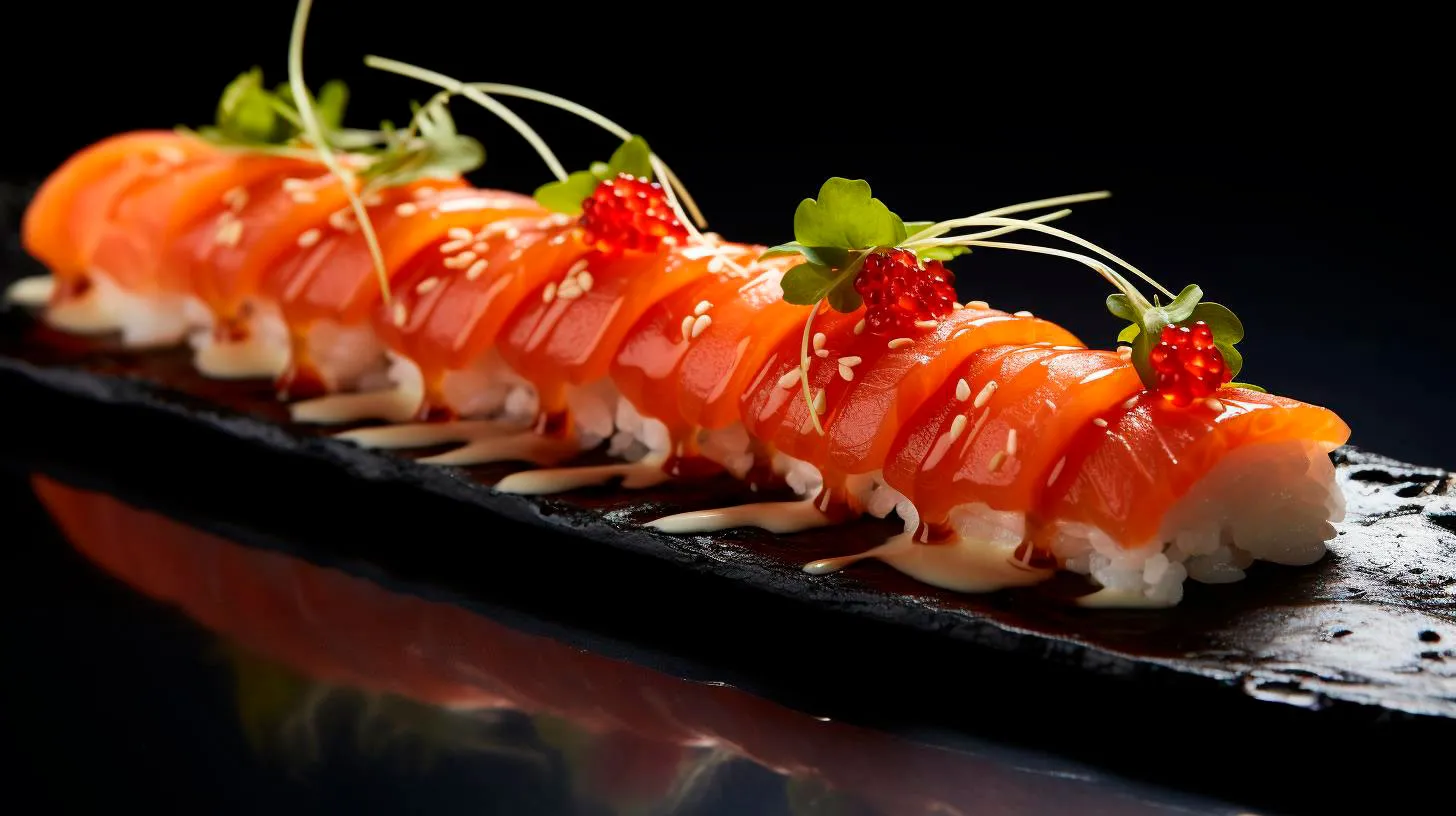Sushi: Unraveling the Art of Crafting Beautiful and Delicious Rolls
Join us on this gastronomic journey as we unlock the secrets behind the allure of sushi.
The History of Sushi
Sushi traces its origins back to ancient Japan during the 8th century. Initially, it was consumed as a preservation method for fish, as fermentation with rice helped preserve the freshness of the seafood. Over the centuries, sushi gradually evolved from a preservation technique to a culinary art form.
Today, sushi has become a symbol of Japanese culture and a testament to the skill and precision of sushi chefs worldwide. It has also adapted to different international flavor palates, with new and creative iterations emerging worldwide.
The Art of Crafting Sushi Rolls
Crafting sushi rolls, or maki-zushi, is a meticulous process that requires both skill and creativity. Here are the key steps involved in crafting these delectable treats:
- Preparation: The sushi chef carefully selects the freshest ingredients, including fish, vegetables, and condiments. The ingredients are then prepared, sliced, and arranged for assembly.
- Assembly: The chef places a sheet of nori (seaweed) on a bamboo mat and spreads a thin layer of sushi rice over it. Various fillings, such as raw fish, avocado, cucumber, or tempura, are placed on top of the rice.
- Rolling: Using the bamboo mat as a guide, the chef rolls the sushi tightly, ensuring the proper shape and alignment of the ingredients.
- Slicing: The rolled sushi is carefully sliced into bite-sized pieces, known as sushi rolls or maki. Precise knife techniques are employed to maintain consistent shape and presentation.
The Health Benefits of Sushi
Sushi is not only a treat for the taste buds but also offers numerous health benefits. Here are a few health advantages of indulging in this delectable Japanese cuisine:
- Low in Calories: Sushi is often low in calories, making it an excellent choice for those seeking a healthy meal option.
- Rich in Omega-3 Fatty Acids: Many sushi ingredients, such as fatty fish like salmon and tuna, contain omega-3 fatty acids that promote heart health.
- Abundance of Nutrients: Sushi rolls are typically filled with a variety of vegetables, providing a good source of vitamins and minerals.
- Probiotic Benefits: Fermented sushi toppings like pickled ginger and soy sauce contain beneficial probiotics that support gut health.
The Cultural Significance of Sushi
Sushi has transcended its geographical boundaries and become an integral part of culinary cultures around the world. Its cultural significance extends beyond its taste and preparation. Here are a few ways sushi showcases its cultural importance:
- Precision and Discipline: Preparing sushi requires precision and discipline, reflecting traditional Japanese values.
- Attention to Detail: Each sushi roll is carefully crafted, emphasizing the importance of meticulous craftsmanship in Japanese culture.
- Ritual and Etiquette: Sushi dining often follows specific rituals and etiquettes, fostering a sense of respect for the food, the chef, and the overall dining experience.
- Global Culinary Fusion: Sushi’s global popularity showcases how cultural crossovers enrich culinary traditions worldwide.
Key Takeaways
Sushi is not just a dish, but an art form that has captured the hearts and palates of people worldwide. From its humble beginnings as a preservation technique to its current status as a global sensation, sushi represents a harmonious blend of tradition, skill, and culinary innovation. With its health benefits, meticulous craftsmanship, and cultural significance, sushi continues to charm both food enthusiasts and novices alike. So, the next time you take a bite of sushi, savor the intricate flavors and appreciate the artistry behind each roll.
Elegant Presence at Weddings: Infusing Japanese Tradition into the Perfect Celebration
This article explores the beauty of incorporating Japanese elements into weddings, from attire and decor to ceremonies and favors.
The Splendor of Japanese Wedding Attire
Traditional Japanese wedding attire, known as “Shiro-muku” or “Iro-uchikake,” boasts exquisite craftsmanship and breathtaking beauty. From the stunning pure white Kimono to the vibrant embroidered silk robes, these garments epitomize elegance and grace. Advantages of embracing Japanese wedding attire include:
- Timeless Beauty: Traditional Japanese wedding attire, with its intricate designs and delicate fabrics, creates a striking and unforgettable visual impact.
- Cultural Significance: Incorporating Japanese wedding attire not only adds a touch of tradition but also showcases respect and appreciation for Japanese culture.
- Versatile Options: Japanese wedding attire offers a range of styles to suit individual preferences, from the simplistic elegance of Shiro-muku to the splendor of Iro-uchikake.
Setting the Stage with Japanese-Inspired Decor
Creating an atmosphere that reflects the essence of Japan will transport guests to a world of timeless beauty. The right decor can enhance the elegance and serenity of a wedding celebration. Consider incorporating these Japanese-inspired elements into your wedding decor:
- Fragrant Cherry Blossoms: Adorn your wedding venue with graceful cherry blossom branches, symbolizing beauty and ephemeral nature of life.
- Minimalistic Zen Gardens: Create a serene ambiance with miniature Zen gardens, featuring raked sand, stones, and carefully placed foliage.
- Delicate Origami: Use origami creations, such as cranes and cherry blossoms, as decorative accents or thoughtful wedding favors.
Captivating Ceremonies with Japanese Traditions
A Japanese-themed wedding ceremony infuses traditional customs and rituals, adding a touch of enchantment to the celebration. Some notable Japanese traditions to consider include:
- San-san-kudo: This ritual involves the couple sipping sake from three cups, symbolizing their union and the bonding of their families.
- Exchange of Nuptial Vows: Incorporate the recitation of Japanese wedding vows, expressing commitment and love in a unique and poetic way.
- Mizuhiki: Utilize intricate Mizuhiki cords in your ceremony, representing good luck, fidelity, and togetherness.
Captivating Favors Inspired by Japanese Culture
Wedding favors are a thoughtful way to express gratitude to guests. Infuse the beauty of Japan into your favors, leaving a lasting impression:
- Japanese Tea Sets: Gift your guests with elegant Japanese tea sets, symbolizing tranquility and reflecting the art of tea ceremonies.
- Handcrafted Kimono Accessories: Consider gifting handcrafted Kimono accessories, such as traditional silk fans or intricate hairpieces.
- Personalized Origami: Fold personalized origami creations, like heart-shaped cranes, with heartfelt messages for each guest.
Key Takeaways
Incorporating Japanese tradition into weddings brings a unique and elegant presence to the celebration. Here are the key takeaways:
- Japanese wedding attire showcases timeless beauty and cultural significance.
- Japanese-inspired decor elements create an ambiance of elegance and serenity.
- Traditional Japanese rituals and customs add enchantment and meaning to the ceremony.
- Thoughtfully selected Japanese-inspired wedding favors leave a lasting impression on guests.
By infusing Japanese tradition into weddings, couples can create a truly unforgettable celebration, filled with elegance, grace, and timeless beauty. Embracing the beauty of Japan allows couples to personalize their special day in a way that is both captivating and culturally meaningful.
A Taste of Japan: Exploring the Rich Flavors and Culinary Delights
In this article, we will take a culinary journey through Japan, exploring its rich flavors and culinary delights.
The Art of Sushi: A Perfect Combination of Taste and Aesthetics
When it comes to Japanese cuisine, sushi is undoubtedly one of the first things that come to mind. This iconic dish consists of vinegared rice combined with various ingredients, such as fresh fish, seafood, or vegetables. Sushi is not only a treat for the taste buds but also a work of art.
Key takeaways:
- Sushi is a perfect harmony of taste and aesthetics.
- Freshness and quality of ingredients are crucial for an exceptional sushi experience.
- There are various types of sushi, including nigiri, maki, and sashimi.
- Wasabi, soy sauce, and pickled ginger are customary accompaniments.
The Flavorsome World of Ramen: A Bowl Full of Comfort
Another beloved Japanese dish is ramen, a soul-warming noodle soup that has become popular worldwide. Originally from China, ramen has been embraced and adapted by the Japanese with their unique culinary flair. This savory dish consists of wheat noodles in a rich broth, topped with a variety of ingredients such as pork, vegetables, and eggs.
Key takeaways:
- Ramen is a comforting and flavorsome noodle soup.
- The broth is a vital element, often simmered for hours to achieve depth of flavor.
- There are several regional styles of ramen, each with its own distinctive broth and toppings.
- A perfectly balanced bowl of ramen is a delight to the senses.
Tempura: A Deep-Fried Delicacy
Tempura, a popular Japanese dish, is another culinary delight worth exploring. It involves deep-frying battered seafood and vegetables, resulting in a crispy and light delicacy. The secret to a perfect tempura lies in the batter’s lightness and the skill of the chef in achieving the right level of crispiness.
Key takeaways:
- Tempura is a delectable deep-fried dish.
- The batter used is light and creates a crispy texture.
- Shrimp, squid, eggplant, and sweet potatoes are commonly used ingredients.
- Tempura is often served with a dipping sauce called tentsuyu.
Matcha: The Elegant Green Tea Experience
No exploration of Japanese cuisine is complete without mentioning matcha, a powdered green tea that holds a special place in Japanese tea ceremonies and culinary creations. Matcha has gained popularity worldwide due to its vibrant green color, unique flavor, and numerous health benefits.
Key takeaways:
- Matcha is a powdered green tea with a distinct taste and appearance.
- It is rich in antioxidants and provides a calming effect.
- Matcha is often used in various desserts, such as cakes, ice cream, and traditional Japanese sweets.
- The preparation of matcha involves a traditional ritual using a bamboo whisk.
Conclusion
Japan’s culinary delights offer a feast for both the senses and the soul. Whether it’s the exquisite artistry of sushi, the heartwarming comfort of ramen, the delicate crispness of tempura, or the elegant experience of matcha, Japanese cuisine has something to offer to every palate. Exploring the rich flavors and culinary traditions of Japan is a culinary adventure that should not be missed.



